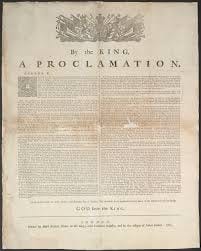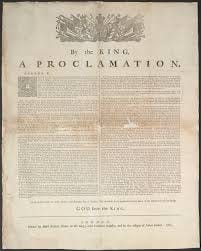King George III’s Royal Proclamation of 1763 remains an important document that set out guidelines for European settlement of territories in what is now North America. The Proclamation was issued by King George III to officially claim British territory in North America after Britain had won the Seven Years War against France. It explicitly states that Aboriginal nationhood rights existed and continues to exist, and that all land would be considered Aboriginal land until ceded by treaty. The Proclamation forbade settlers from claiming land from the Aboriginal occupants, unless it has been first bought by the Crown and then sold to the settlers. The Royal Proclamation further sets out that only the Crown can buy land from First Nations.
Specifically, the Proclamation states:
“And whereas Great Frauds and abuses have been committed in purchasing lands of the Indians, to the great prejudice of our interests, and to the great dissatisfaction of the said Indians; In order, therefore, to prevent such irregularities for the future, and to the End that the Indians may be convinced of our justice and determined resolution to remove all reasonable cause of discontent, we do, with the advice of our privy council strictly enjoin and require, that no private person do presume to make any purchase from the said Indians of any Lands reserved to the said Indians, within those parts of our Colonies where, we have thought proper to allow settlement; but that, if at any Time any of the said Indians should be inclined to dispose of the said Lands, the same shall be purchased only for us, in our name, at some public meeting or assembly of the said Indians, to be held for the purpose by the Governor or Commander in Chief of our Colonies respectively within which they shall lie...”
The Proclamation remains the basis for establishing and understanding the concept of Aboriginal Title. Aboriginal Title refers to the inherent Aboriginal right to ‘’own’’ land or a territory. The Canadian legal system now recognizes Aboriginal title as a sui generis, which means it has been establishes as its own unique collective right in this case to the use of and jurisdiction over a group’s ancestral territories. It is an important legal concept that has informed many precedent setting Canadian legal cases. Notwithstanding, the simplicity of it is that the Crown established that in the territory that became Canada all land belonged to indigenous people unless it was ceded to the Crown (by purchase or treaty).
Just as importantly, the Royal Proclamation establishes foundational considerations that ought to, in part, govern the relationship between the Crown and Canada’s indigenous people. Collectively we ought to look at the Royal Proclamation for guidance. As a result then one of the goals of reconciliation becomes: to ensure that…Indians may be convinced of our justice and determined resolution to remove all reasonable cause of discontent”.
In order to achieve the goal of removing all discontent the government and its agents (including all government employees) are required to be guided by the honour of the Crown. This means that the government is required constitutionally to always “act honourably” in the Crown’s dealings with Indigenous peoples, in the making and applying of treaties, and in protecting Aboriginal or Treaty rights as recognized and affirmed under s. 35 of the Constitution Act, 1982. This includes consulting and accommodating Indigenous communities when the Crown would undertake or consider an action that would potentially have adverse effects upon s.35 Aboriginal or Treaty rights. The honour of the Crown requires the Crown (which means all government elected officials and employees) to interpret its constitutional obligations broadly and purposefully while diligently fulfilling them and prohibits even “the appearance of sharp-dealings” in the relationship between the Crown and Indigenous peoples.
While it is generally recognized that in our historic dealings with various Indigenous groups, Canada and Canadians have not acted in ways consistent with the honour of the Crown, our hope is that we are now in the 21st century evolving to a point where we are guided by the very principles established by King George III when dealing with Canada’s original people. Unfortunately, this is not the case as demonstrated by the recent decision of The Supreme Court of Canada with respect to the Robinson Treaties.
The Robinsons Treaties were negotiated on behalf of the Crown with Anishinaabe of Lake Huron and Lake Superior. The history behind why these treaties came about is interesting and worth further commentary but more than we afford here. Suffice to say that at the time the Robinson Treaties were being negotiated, the Canadian economy was evolving away from the fur trade and towards future growth which would come through the exploitation of Canada’s natural resources and in particular from the vast potential of its mineral resources.
In 1845 the prevailing government did not actually know what the potential for mineral development was, but based on successful copper mining operations on the upper Michigan Peninsula it was believed that the resources in the Canadian Shield in what is now the northwestern part of Ontario could be significant. In order to fulfill its obligations to the indigenous people the government of the day sent a representative, William Benjamin Robinson, a man with knowledge of indigenous culture and language, to purchase land on behalf of the Crown and to negotiate treaties with the Anishinaabe. These treaties were made in 1850 and included provisions for reserve lands, guarantees of indigenous hunting and fishing rights and the payments of certain royalties or annuities for the mineral rights.
The treaties provided for the increase of the annuities over time under certain circumstances. This part of the treaty, known as the “Augmentation Clause”, also provided that the amount “paid to each individual” each year would not exceed £1 (equivalent to $4), but the Crown had the power to increase it to a higher amount chosen at its discretion. The annuities were increased to $4 to each individual in 1875, but have not been increased since then, despite the specific requirement for the government to continuously review such payments.
Flash forward to modern times. In 2001, the Anishinaabe of Lake Superior (“Superior plaintiffs”) filed a claim against the Crown alleging a breach of the Augmentation Clause and its fiduciary duty to indigenous people because of the failure to increase the annuities. In 2014 they were joined by the Anishinaabe of Lake Huron. Fiduciary duty means that Canada as a nation is obliged to act in the best interest of Indigenous Peoples – for some of this this implicitly is part of maintaining the honour of the Crown. In this case, the plaintiffs asked the court to compensate them. The trial judge concluded that, under the Augmentation Clause, the Crown has a duty to increase the annuities when the economic circumstances warrant it, reflecting a “fair share” of the revenues received by the Crown from the land. The trial judge said in ruling in favour of the plaintiffs that the honour of the Crown and a fiduciary duty required the Crown to diligently implement the Augmentation Clause and noted it has failed to do so.
Since then, the matter has been appealed by the Ontario government and has eventually found its way to the Supreme court of Canada who rendered a decision recently with respect to the matter. Notwithstanding, for us lay people who may not have the advantages of insight afforded by a law degree, it seems somewhat dishonourable for the government to resort to litigating the matter rather than negotiating a fair and decent settlement.
Legal arguments can easily devolve into ludicrous disputes over the meaning of a word or the placement of a comma rather than concentrating on intent and outcome. While the augmentation clause required the Crown to increase payments from time to time when circumstances dictated, the province of Ontario argued that it owed nothing because it actually suffered a loss over time as a result of its investment in the infrastructure needed to access resources. The government argued that its investment far exceeded the value of the revenue generated from mineral exploitation. While such an argument confirms the fact that governments are poor decision-makers with respect to investment decisions, it also is irrelevant to their underlying obligation to make fair payments to the people the Crown had negotiated with regarding their mineral rights.
Regardless of the details regarding how the Treaties should be interpreted, the eventual outcome delivered in the Supreme Court of Canada’s (SCC) decision was: payments should be reviewed and increased with a frequency consistent with the honour of the Crown. The SCC concluded that the breach of duty under the Robinson Treaties was longstanding and egregious and the SCC directed Ontario to engage in time-bound and honourable negotiation with the Lake Superior plaintiffs about compensation for past breaches. The court further noted that although no specific fiduciary duties apply in respect of the Augmentation Clause promise, the honour of the Crown requires the Crown to diligently fulfill this promise.
The Supreme Court of Canada decision notes:
"For almost a century and a half, the Anishinaabe have been left with an empty shell of a treaty promise, It is time for the parties to return to the council fire and rekindle the perpetual relationship that the Robinson Treaties envision. Nothing less will demonstrate the Crown's commitment to reconciliation."
In 2023, the Anishinaabe of Lake Huron settled their similar case with the Ontario and Federal Governments in exchange for a payment of $10 billion for past breaches of the Robinson-Huron Treaty. Ontario and the Federal government have split that settlement obligation between them 50/50. However, the Anishinaabe of Lake Superior have not agreed to a settlement yet.
These cases highlight an overall concern Canadians ought to be raising. That being that the Federal and Provincial governments have developed a long record of pushing matters through litigation to be decided by the courts rather simply living up to the Crown’s obligations (their obligations!) to Canada’s indigenous people. By failing to live up to the honour of the Crown our governments continuously bring shame to the Canadian people and fail us in promoting efforts to reconcile by instead sponsoring litigation, leading to undue delays, hurt feelings and an enormous strain on the relationships. Reconciliation is not a legal matter. It is a relationship matter between people of different nations who desperately need to find ways to coexist and thrive.
Please Share this Article with others who would enjoy or benefit from this reading
Share link to all our previous Articles:
Subscribe to our regular mailings:




